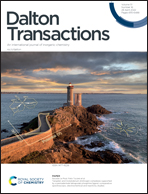GdIII and GaIII complexes with a new tris-3,4-HOPO ligand as new imaging probes: complex stability, magnetic properties and biodistribution†
Abstract
The development of metal-based multimodal imaging probes is a highly challenging field in coordination chemistry. In this context, we have developed a bifunctional hexadentate tripodal ligand (H3L2) with three 3,4-HOPO moieties attached to a flexible tetrahedral carbon bearing a functionalizable nitro group. Complexes formed with different metal ions have potential interest for diagnostic applications, namely magnetic resonance imaging (MRI) and positron emission tomography (PET). The capacity of the ligand to coordinate GdIII and GaIII was studied and the thermodynamic stability constants of the respective complexes were determined by potentiometry and spectrophotometry. The ligand forms stable 1 : 1 ML complexes though with considerably higher affinity for GaIII than for GdIII (pGa = 26.2 and pGd = 14.3 at pH 7). The molecular dynamics simulations of the GdIII complex indicate that two water molecules can coordinate the metal ion, thus providing efficient paramagnetic enhancement of water proton relaxation. The relaxation and the water exchange properties of the GdIII chelate, assessed by a combined 17O NMR and 1H NMRD study, showed associative activated water exchange with a relatively low rate constant, k298ex = (0.82 ± 0.11) × 107 s−1, and some aggregation tendency. Biodistribution studies of the 67Ga-L2 complex suggested good in vivo stability and quick renal clearance. Further anchoring of this ligand with specific biotargeting moieties might open future prospectives for applications of labelled conjugates in both MRI and 68Ga-PET diagnostic imaging.



 Please wait while we load your content...
Please wait while we load your content...